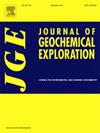韩国Boreum岛岩浆铁钛氧化物矿床形成的结构和地球化学限制
IF 3.3
2区 地球科学
Q1 GEOCHEMISTRY & GEOPHYSICS
引用次数: 0
摘要
本文通过野外观测、岩石学、地球化学等综合手段,研究了北纬岩浆岩型氧化铁钛矿床的复杂岩浆过程。该矿床位于朝鲜半岛中西部的京畿地块边缘地带,是韩国最重要的铁钛氧化物省之一,为了解矿石形成机制提供了理想的自然实验室。薄层状的Boreum超镁质岩石(宽30米,长300米)侵入了古元古代的Boreumdo片岩,包括三个不同的阶段:放光石、透辉石和橄榄石为主。横切关系表明通过多次熔体注入而不是单一熔体分馏过程形成。铁钛氧化物矿化不均匀地富集在以橄榄石为主的高断裂相中,形成浅岩脉网络。以磁铁矿和钛铁矿为主,辅之以磷铁矿和钙钛矿(限于透辉为主相)。磁铁矿显示出复杂的溶出结构,表明在缓慢冷却过程中存在亚固态再平衡。相容元素(Cr: 25,622-140,526 ppm; Ti: 18,160-87,919 ppm; V: 2421-18,433 ppm)在岩浆Fe-Ti, V矿床组成域中显著富集。矿物化学表明在低氧逸度条件下(ΔFMQ−2.60 ~ +0.69),高温磁铁矿结晶(TMg-Mag = 885 ~ 607°C, TIlm-Mag = 754 ~ 594°C)。磁铁矿δ56Fe(+0.12 ~ +0.40‰)和δ18O(- 0.75 ~ +2.89‰)值受限制,与岩浆成因一致。铁钛氧化物矿化是由于高温岩浆熔体迁移到已经凝固的超铁质岩石中,而不是原位结晶或结晶沉降。这些发现为研究镁铁质-超镁铁质侵入体中形成铁钛氧化物矿床的岩浆过程提供了新的认识。本文章由计算机程序翻译,如有差异,请以英文原文为准。
Textural and geochemical constraints on the formation of the magmatic Fe–Ti oxide deposit at Boreum Island, South Korea
This paper investigates the complex magmatic processes of the Boreum magmatic Fe–Ti oxide deposit through comprehensive field observation, petrography, and geochemistry. Located in the marginal zone of the Gyeonggi Massif, central-western Korean Peninsula, this deposit represents one of South Korea's most important Fe–Ti oxide provinces, providing an ideal natural laboratory for understanding ore formation mechanisms. The sill-like Boreum ultramafic rocks (30 m wide, 300 m long) intrude Paleoproterozoic Boreumdo schist and comprise three distinct phases: actinolite-, diopside-, and olivine-dominant. Cross-cut relationships indicate formation through multiple melt injections rather than single-melt fractionation processes. Iron–Ti oxide mineralization concentrates unevenly in the highly fractured olivine-dominant phase as sill-dyke networks. Magnetite and ilmenite are dominant, with subordinate pleonaste and perovskite (restricted to diopside-dominant phase). Magnetite shows complex exsolution textures indicating subsolidus re-equilibration during slow cooling. It is significantly enriched in compatible elements (Cr: 25,622–140,526 ppm; Ti: 18,160–87,919 ppm; V: 2421–18,433 ppm), plotting within magmatic Fe–Ti, V deposit compositional fields. Mineral chemistry reveals high-temperature magnetite crystallization (TMg-Mag = 885–607 °C, TIlm-Mag = 754–594 °C) under low oxygen fugacity conditions (ΔFMQ −2.60 to +0.69). Magnetite exhibits restricted δ56Fe (+0.12 to +0.40 ‰) and δ18O (−0.75 to +2.89 ‰) values, consistent with magmatic origin. Fe–Ti oxide mineralization resulted from high-temperature magmatic melt migration into already solidified ultramafic rocks, not in situ crystallization or crystal settling. These findings provide new insights into magmatic processes forming Fe–Ti oxide deposits in mafic–ultramafic intrusions.
求助全文
通过发布文献求助,成功后即可免费获取论文全文。
去求助
来源期刊

Journal of Geochemical Exploration
地学-地球化学与地球物理
CiteScore
7.40
自引率
7.70%
发文量
148
审稿时长
8.1 months
期刊介绍:
Journal of Geochemical Exploration is mostly dedicated to publication of original studies in exploration and environmental geochemistry and related topics.
Contributions considered of prevalent interest for the journal include researches based on the application of innovative methods to:
define the genesis and the evolution of mineral deposits including transfer of elements in large-scale mineralized areas.
analyze complex systems at the boundaries between bio-geochemistry, metal transport and mineral accumulation.
evaluate effects of historical mining activities on the surface environment.
trace pollutant sources and define their fate and transport models in the near-surface and surface environments involving solid, fluid and aerial matrices.
assess and quantify natural and technogenic radioactivity in the environment.
determine geochemical anomalies and set baseline reference values using compositional data analysis, multivariate statistics and geo-spatial analysis.
assess the impacts of anthropogenic contamination on ecosystems and human health at local and regional scale to prioritize and classify risks through deterministic and stochastic approaches.
Papers dedicated to the presentation of newly developed methods in analytical geochemistry to be applied in the field or in laboratory are also within the topics of interest for the journal.
 求助内容:
求助内容: 应助结果提醒方式:
应助结果提醒方式:


